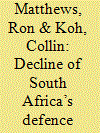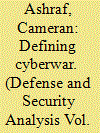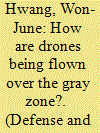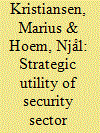|
|
|
Sort Order |
|
|
|
Items / Page
|
|
|
|
|
|
|
| Srl | Item |
| 1 |
ID:
181221


|
|
|
|
|
| Summary/Abstract |
There is scant research on models for visualising strategies retrospectively. The authors present a new analytical, visual methodology for assessing the transformation of armed forces, which is usually considered to be the “second dimension” of strategy. It is novel and generally applicable to armed forces, and additionally provides several benefits, in particular with regard to its synoptic character. The methodology translates a sociological approach into strategic studies, a discipline which has not really developed its own yet. It is exemplified by means of the (airborne part of the) Swiss Air Force's transformation since the end of the Cold War.
|
|
|
|
|
|
|
|
|
|
|
|
|
|
|
|
| 2 |
ID:
181216


|
|
|
|
|
| Summary/Abstract |
The growth of South Africa’s apartheid era defence industry was propelled by international isolation following the 1984 UN arms embargo and revealed military technology deficiencies during the border war. Weapons innovation became an imperative, fostering development of frontier technologies and upgrades of legacy platforms that drove expansion in arms exports. However, this golden era was not to last. The 1994 election of the country’s first democratic government switched resources from military to human security. The resultant defence-industrial stagnation continues to this day, exacerbated by corruption, unethical sales, and government mismanagement. The industry’s survival into the 2020s cannot be assured.
|
|
|
|
|
|
|
|
|
|
|
|
|
|
|
|
| 3 |
ID:
181217


|
|
|
|
|
| Summary/Abstract |
For nearly thirty years scholars have offered changing definitions of cyberwar. The continued ambiguity demonstrates that efforts at establishing definitional clarity have not been successful. As a result, there are many different and contradictory definitions, ranging from cyberwar’s non-existence to cyberwar as an imminent threat. Ongoing definitional ambiguity makes interdisciplinary research and policy communications challenging in this diverse field. Instead of offering a new definition, this paper proposes that cyberwar can be understood through a fluid framework anchored in three themes and five variables identified in a broad interdisciplinary survey of literature. This framework's applicability is demonstrated by constructing an example definition of cyberwar utilising these themes and variables.
|
|
|
|
|
|
|
|
|
|
|
|
|
|
|
|
| 4 |
ID:
181219


|
|
|
|
|
| Summary/Abstract |
Drones have been affecting many areas since their advent, including conflicts between states. Used as a coercive measure, how they are flown by measured or limited revisionists can be understood in terms of the gray zone strategy. The concept of the gray zone is somewhere between peace and war, and the gray zone strategy enables revisionists to gradually alter the status quo without triggering war or overt conflict. Both theoretically and empirically, drones could be a useful tool in gray zone conflicts. This paper attempts to specify and organise such operations according to the question: “How are drones being flown over the gray zone?” Revisionist states fly drones based on the salami tactic, or feigned innocence, or by putting them in the hands of proxy forces to expand gradually their interests and destabilise troubled regions; therefore, understanding drone strategy and considering counter-measures are indispensable for securing stability in such regions.
|
|
|
|
|
|
|
|
|
|
|
|
|
|
|
|
| 5 |
ID:
181220


|
|
|
|
|
| Summary/Abstract |
Security and defence policy documents have sparked academic interest since their publication has become a common international practice in the 1990s. Yet, broad comparisons across time and countries have been scarce. This article presents information from a new dataset on security and defence documents published by OECD countries. Specifically, we analyse what type of documents were published by each country between 1990 and 2019, which security concerns they identify, and what level of importance is given to different agendas of security and defence. The dataset reveals an unexpected level of diversity, including an apparent lack of a common framework even among countries belonging to NATO or the European Union. In terms of content, there was a recent recurrence of traditional security topics, along with the prominence of some newer ones. Overall, the documents reveal a surprising lack of consistency and completeness with regards to provisions for policy execution.
|
|
|
|
|
|
|
|
|
|
|
|
|
|
|
|
| 6 |
ID:
181218


|
|
|
|
|
| Summary/Abstract |
In a world of global interdependent security, the West is increasingly involved in the stability of all regions that could directly or indirectly influence national interests. To this end, security sector assistance (SSA), with its’ perceived favourable effect-to-resource-ratio, has become somewhat of a panacea. For small states, coalition SSA has become the way to pursue own ambitions with military means internationally. But SSA is a difficult task, especially for miniscule contributors with scarce resources. We therefore ask: How can small states achieve the highest yield from their SSA-efforts? From a Norwegian perspective, and focusing on the SOF component, this article provides a practitioner’s view on how to increase the military contribution to strategic utility. Through understanding the wicked problem SSA represents, and adhering to the principles of long-term commitment, vertical implementation, and specialised skillsets, we argue small states might gain a disproportionate advantage allowing them to punch above own weight.
|
|
|
|
|
|
|
|
|
|
|
|
|
|
|
|
|
|
|
|
|